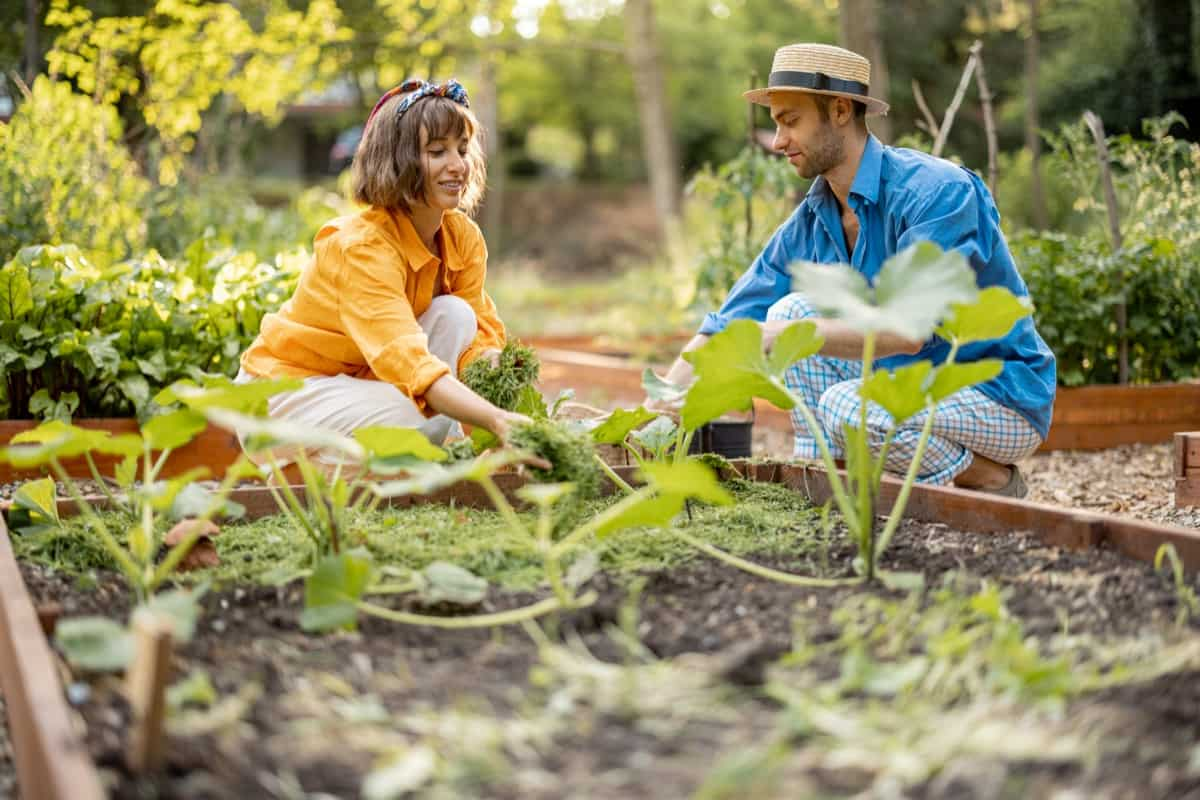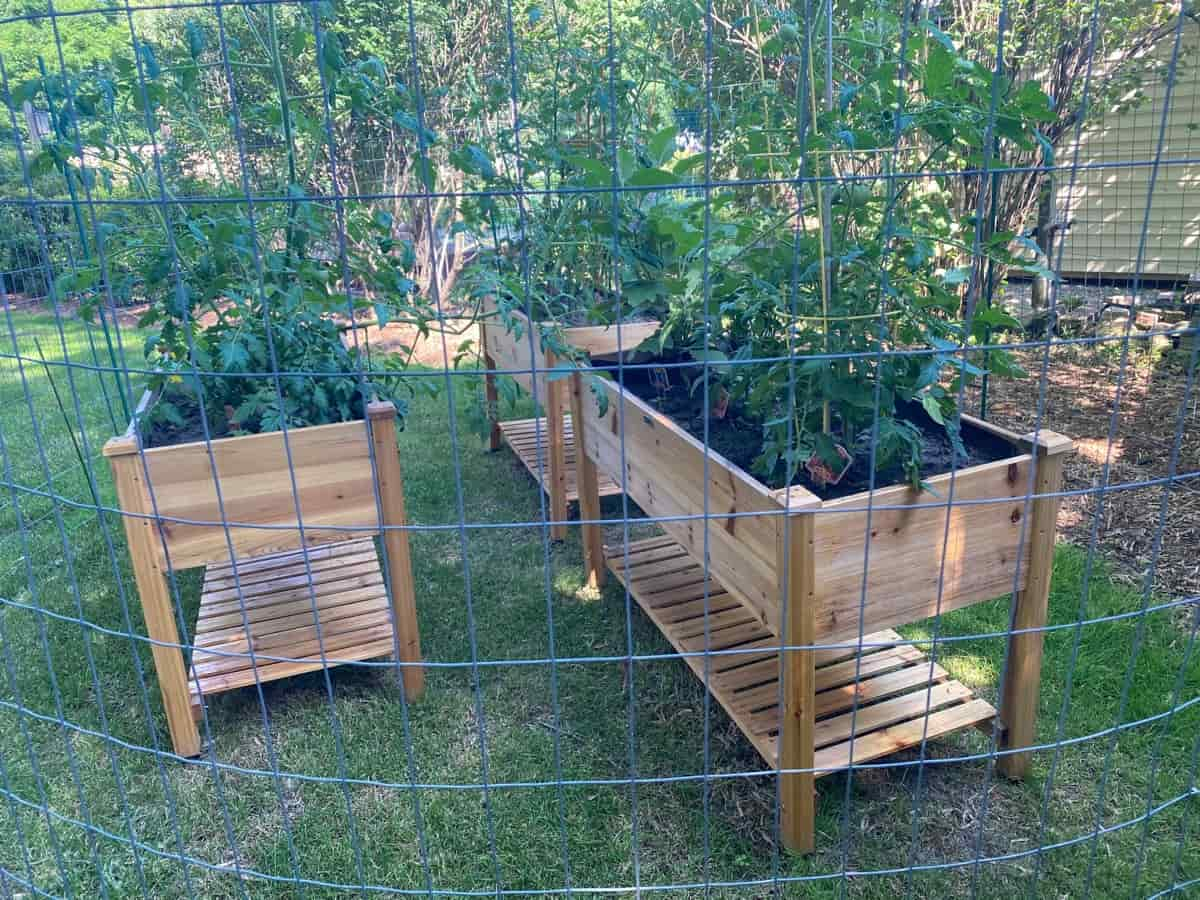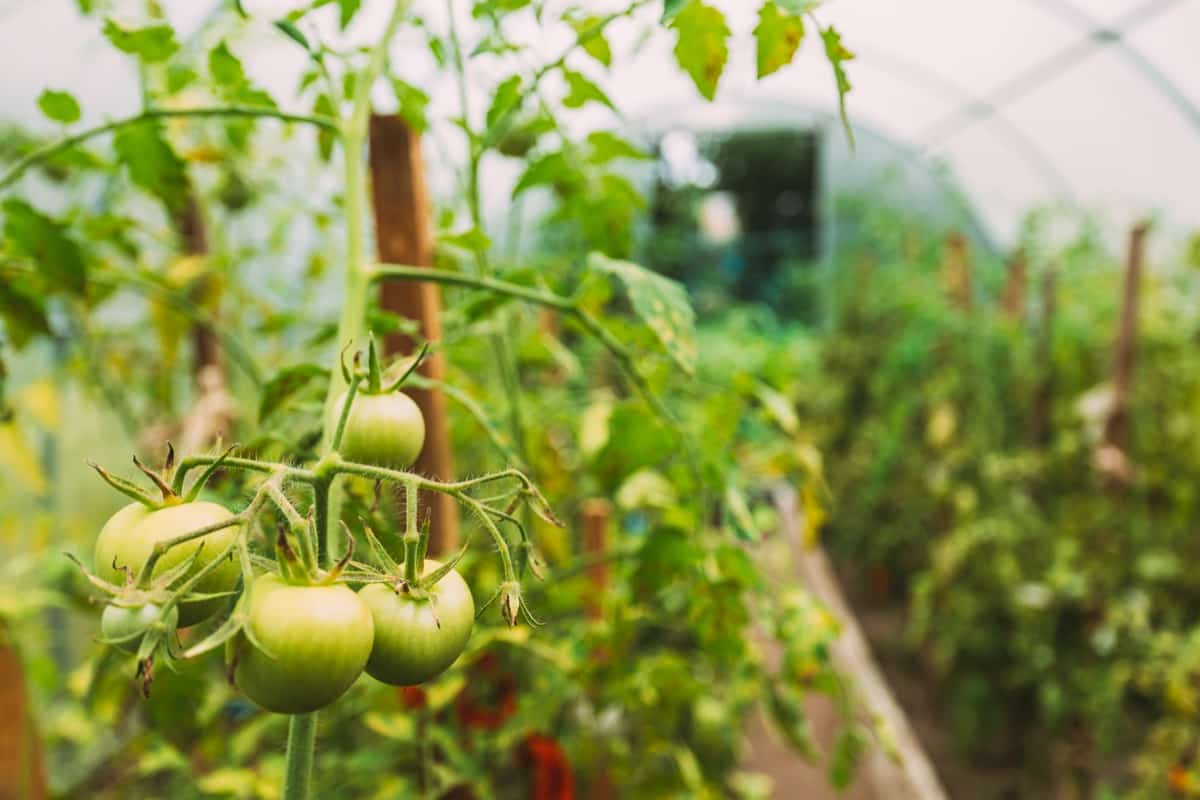If you’re like many gardeners, you’ve probably experienced your fair share of challenges when growing vegetables in raised beds. Raised bed vegetable gardening offers numerous benefits for home gardeners. However, just like any form of gardening, it has challenges. You can ensure a successful and bountiful harvest by being aware of the common problems that can arise with raised bed vegetable plants and taking proactive measures to prevent, treat, and find solutions to these issues.

Problems with Raised Bed Vegetable Plants
Yellowing Leaves in Raised Bed Vegetable Plants
This issue has several potential causes, and it’s important to identify the problem early on to prevent further damage. One possible reason for yellowing leaves is nutrient deficiencies. Plants need a balanced supply of nitrogen, phosphorus, and potassium to thrive. If these nutrients are lacking in the soil or not absorbed properly by the plant’s roots, it can result in yellowing leaves.
Another common culprit is overwatering. While keeping your raised bed plants adequately hydrated is important, too much water can lead to root rot and oxygen deprivation. This can manifest as yellowing leaves and wilting plants. Environmental factors such as excessive heat or lack of sunlight can contribute to leaf yellowing. Ensure your raised bed garden receives adequate sunlight throughout the day to promote healthy growth.
Pest Control for Raised Bed Vegetable Plants
Keeping pests away from your raised bed vegetable plants is essential for a thriving garden. By strategically placing certain plants together, you can repel pests or attract beneficial insects that prey on them. Another option is using physical barriers like row covers or netting to keep insects out of your raised beds. This method provides a protective shield, allowing air and sunlight to reach your plants.
If you prefer organic solutions, consider making homemade pest deterrents such as garlic spray or neem oil-based products. These concoctions are safe for the environment, and your vegetables but effectively repel unwanted visitors. Regularly inspecting your plants can also help detect early signs of pest infestation. Look out for chewed leaves, fruit holes, or sticky residue from sap-sucking insects like aphids. Keeping the area clean and removing any fallen foliage or weeds will discourage pests from a residence in the first place.
In case you missed it: How to Improve Drainage in a Raised Garden Bed

Overwatering Issues in Raised Bed Vegetable Plants
Overwatering can be a common problem in raised bed vegetable gardens, and it’s important to find the right balance when watering your plants. While water is essential for their growth, too much of it can lead to various issues. One issue that arises from overwatering is root rot. When the soil becomes saturated with water, the roots cannot get enough oxygen, leading to rotting. This can cause stunted growth and even death of the plants. Another problem caused by overwatering is nutrient leaching.
When there is excessive water in the soil, nutrients get washed away before the plants can absorb them. This can result in nutrient deficiencies and poor plant health. Overwatered plants may also develop yellowing leaves or wilt despite having sufficient moisture. This happens because excess water leads to reduced uptake of nutrients and prevents proper root development.
To prevent overwatering, make sure you are watering your raised bed vegetable garden appropriately. Consider using well-draining soil mixtures in your raised beds and providing adequate drainage through holes or gravel at the bottom of containers. These measures will help ensure that excess water has somewhere to go instead of sitting around roots.
Nutrient Deficiencies in Raised Bed Vegetable Plants
| Nutrient deficiency | Symptoms | Treatment measures |
| Nitrogen | If your plants have pale or yellow leaves, it could indicate a lack of nitrogen. | To remedy this, you can apply organic fertilizers or compost-rich nitrogen to replenish the soil’s nutrient levels. |
| Magnesium | Magnesium deficiency may be the culprit if you notice yellowing between veins on older leaves. | Adding bone meal to the soil can help address this deficiency. |
| Potassium | Signs of potassium deficiency include curled leaf edges and weak stems that easily break. | Add wood ash or potash to infuse potassium into the soil to rectify this issue. |
In case you missed it: Top 10 Best Vegetables to Grow in Raised Beds: Ultimate Guide for Planting to Harvest

Wilting Plants in Raised Beds
Wilting is a common problem gardeners may encounter with their raised bed vegetable plants. This can be a cause for concern, as it indicates that something is amiss with the health and well-being of your plants. Wilting can occur for various reasons, so it’s important to identify the underlying cause to take appropriate action. One possible reason for wilting plants in raised beds is underwatering.
If your plants do not receive enough water, they will droop and wilt. To remedy this issue, make sure you are watering your plants regularly and providing them with an adequate amount of moisture. On the other hand, overwatering can also lead to wilting in raised bed vegetables. Excessive moisture can suffocate plant roots and prevent them from absorbing necessary nutrients. To combat this problem, ensure your raised bed has proper drainage and avoid overwatering your plants.
Another potential culprit behind wilting could be nutrient deficiencies. When plants lack essential nutrients like nitrogen or potassium, they may struggle to maintain their vitality and appear wilted. Consider using organic fertilizers or compost to enrich the soil in your raised bed and provide your plants with the necessary nourishment. Additionally, pests such as aphids or spider mites can attack the leaves of vegetable plants and cause wilting symptoms.
Common Diseases in Raised Bed Vegetable Plants
| Diseases | Symptoms | Prevention |
| Fusarium wilt | It causes the plant’s lower leaves to wilt, followed by yellowing and browning of foliage. | This soil-borne fungus can persist for years, so crop rotation is essential to prevent its recurrence. |
| Downy mildew | It presents as yellow patches on the upper surface of leaves with fuzzy gray mold underneath. | Regular inspection and good airflow around plants can help minimize its impact. |
| Bacterial spot | It appears as small black lesions surrounded by a yellow halo on both leaf surfaces. | Crop rotation coupled with resistant varieties helps control this problem. |
In case you missed it: How to Grow Tabasco Peppers from Seeds: At Home, In Pots, Raised Beds, Terraces, and Backyard

Fungal Infections in Raised Bed Vegetable Plants
| Fungal infection | To control leaf spots, remove affected leaves promptly and avoid overhead watering. | Preventive measures |
| Powdery mildew | This fungus appears as a white or grayish powder on the leaves of your plants. | To treat powdery mildew, use organic fungicides or make your DIY spray using baking soda and water. |
| Damping-off disease | This infection affects seedlings and causes them to rot at the base and topple over. | To prevent damping-off disease, use sterilized potting soil when starting seeds and avoid overwatering. |
| Leaf spot | It appears as small brown spots on the leaves, which eventually turn yellow or black. | To control leaf spot, remove affected leaves promptly and avoid overhead watering. |
| Downy mildew | It shows yellow patches on the leaf’s upper surfaces and a fuzzy white growth underneath. | Preventive measures include spacing plants properly for good air circulation and avoiding wet foliage during watering. |
Weed Management in Raised Bed Gardens
One common problem many gardeners face in their raised bed vegetable gardens is the invasion of weeds. These pesky plants can quickly take over and compete with your vegetables for water, nutrients, and sunlight. To effectively manage weeds in your raised bed garden, it’s important to implement a proactive approach. Start by regularly inspecting your garden beds and removing any emerging weeds when you spot them. This will prevent them from establishing deep roots and spreading throughout the bed.
Another effective weed management technique is mulching. Applying organic mulch around your vegetable plants helps to suppress weed growth. Additionally, mulch helps moisture in the soil, reducing evaporation and benefiting your vegetable plants. Remember that prevention is key when managing weeds in raised bed gardens. Regularly maintaining your beds by removing any potential weed seeds before they germinate will save you time and effort.
Sunlight Requirements for Raised Bed Vegetables
Proper sunlight exposure is crucial for the success of your raised bed vegetable garden. Different vegetable plants have varying sunlight requirements, so it’s important to understand their needs. Leafy greens like Lettuce and Spinach thrive in partial shade, preferring about 4-6 hours of direct sunlight daily. These cool-season crops can tolerate shade but need enough light to grow and produce tasty leaves.
On the other hand, fruiting vegetables such as Tomatoes and Peppers require full sun. They need at least 6-8 hours of direct sunlight daily to develop robust foliage and produce abundant fruits. Without sufficient sun exposure, these plants may become leggy or fail to bear fruit altogether. Herbs like Basil and Rosemary also appreciate plenty of sunshine. These aromatic plants enjoy basking in full sun for around 6-8 hours daily, which helps intensify their flavors.
To optimize sunlight absorption, position your raised beds where they receive maximum exposure throughout the day. Avoid areas shaded by buildings or tall trees that may obstruct the sunlight. Additionally, consider using reflective materials like white plastic or aluminum foil on adjacent surfaces to bounce more light onto your plants’ leaves. Remember to rotate your crops annually within different areas of your garden bed to ensure all areas receive adequate sunlight over time.
Improving Soil Quality in Raised Bed Vegetable Gardens
Improving the soil quality in your raised bed vegetable garden is essential for ensuring healthy plant growth and a bountiful harvest. The right soil composition provides the nutrients, drainage, and structure plants need to thrive. Add organic matter to your raised bed. This will add valuable nutrients and improve the overall structure of the soil. Ensure proper drainage by incorporating perlite or vermiculite into the soil mix.
In case you missed it: How to Grow Ghost Peppers from Seed: At Home, in Pots, Raised Beds, Terrace, and Backyard

These additives help prevent waterlogging, which can lead to root rot. Test your soil’s pH level regularly and adjust it if needed. Most vegetables prefer slightly acidic to neutral soils (pH 6-7). You can use amendments like lime or sulfur to raise or lower pH levels accordingly. Applying organic mulch such as straw or wood chips helps retain moisture in the soil while suppressing weeds. Rotate your crops each year to prevent nutrient depletion and minimize disease buildup in the soil.
Dealing With Overcrowding in Raised Bed Plantings
Dealing with overcrowding in raised bed plantings can be challenging, but you can create a thriving garden space with the right strategies and techniques. One main issue that arises from overcrowding is competition for resources. This causes stunted growth and poor overall health of your plants. To address this problem, properly spacing out your plants when planting them is important.
Each type of vegetable has specific spacing requirements that should be followed to ensure optimal growth. Additionally, regularly thinning your plants as they grow will help prevent overcrowding. Another tactic you can employ is using vertical gardening techniques. You maximize space utilization and minimize crowding by training certain vine crops like tomatoes or cucumbers to grow up trellises or stakes instead of sprawling on the ground.
Furthermore, consider companion planting, which involves growing compatible plants together nearby. This helps deter pests and maximizes space usage by promoting healthy growth habits between different plant species. Regular monitoring and maintenance are essential for preventing overcrowding in raised bed plantings. Keep an eye on how your vegetables grow throughout the season and take action if any signs of crowding appear.
Mulching Techniques for Raised Bed Vegetables
Mulching is a crucial technique for maintaining the health and productivity of raised bed vegetable plants. Several options exist when choosing the right mulching material for your raised bed garden. Straw is a popular choice due to its affordability and ability to break down over time, enriching the soil. Wood chips can also be used but may take longer to decompose.
Also, leaves and grass clippings from your yard can be utilized as free sources of mulch. Remove any existing weeds or debris from the soil’s surface to apply mulch effectively in your raised beds. Then spread a layer of mulch about 2-3 inches thick around your vegetable plants while leaving space around their stems for air circulation.
It’s important to note that it’s best to thoroughly water before adding the mulch layer when applying it in hot climates or during dry periods. This will help prevent moisture loss from evaporation and ensure proper plant hydration. As time passes and you notice that the initial layer of mulch begins to decompose or thin out, you can replenish it by adding another layer. This will maintain all the earlier benefits while providing additional protection against weed growth.
In case you missed it: 9 Common Raised Bed Gardening Mistakes: Every Gardener Must Avoid Them

Harvesting Tips for Raised Bed Vegetable Plants
Harvest your vegetables at their peak ripeness. This will vary depending on the plant, so familiarize yourself with each variety’s ideal harvest time. Invest in good-quality pruning shears or scissors to avoid damaging plants while harvesting. Dull blades can crush stems and leaves, increasing the risk of disease. Handle your harvested produce with care to prevent bruising or damage. Place them gently into baskets or containers to maintain their freshness and flavor.
Rather than pulling out entire plants, opt for selective picking by removing only outer leaves as needed. This allows continuous growth throughout the season. Regularly trimming herbs like basil, mint, and parsley encourage bushier growth and a constant supply of fresh leaves for culinary use. Harvesting early in the day when temperatures are cooler helps retain vegetable flavor and nutrients before the heat causes wilting or deterioration.
Conclusion
By implementing proper watering techniques, ensuring adequate sunlight exposure, practicing crop rotation, and using organic pest control methods, you can minimize the risk of encountering these problems in the first place. However, if issues do arise despite your best efforts at prevention, timely treatment is crucial. Identifying the problem early on allows for swift action to be taken. Experimentation and a willingness to try different solutions will ultimately lead you toward finding what works best in your gardening journey.
- Broccoli Seed Germination and Selection
- Asparagus Seed Germination and Variety Selection
- Seasonal Flower Gardening: Best Practices for Spring, Summer, Fall, and Winter
- How to Grow Hibiscus from Flower
- Plantation Ideas for Home Decoration: A Beginners Guide
- Flower Garden Designs and Layouts for Beginners
- Planting and Spacing Techniques in Papaya: A Beginner’s Guide
- Growing Gold: Essential Techniques for Planting Pineapples
- How to Make Kalanchoe Plant Bushy: Home Remedies and Solutions
- 11 Reasons Why Your Gardenia is Not Blooming: Home Remedies and Solutions
- Eco Elegance: The Guide to Designing a Drought-Tolerant Landscape
- Gardening on a Slope: Strategies for Hillside Landscaping
- Nourish and Flourish: Top Organic Mulches for Thriving House Plants
- Everything You Want to Know about Indian Mogra Flower: Discover Uses and Growing
- Green Thumb Success: Expert Tips for Cultivating Greenhouse Pumpkins All Year Round
- Maximize Growth & Flavor: The Ultimate Guide to Companion Planting in Herb Gardens
- How to Control Rhododendron Problems Naturally: Home Remedies and Organic Ways to Fix Them
- Natural Magic: The Remarkable Benefits of Cinnamon for Plants
- Best Steps to Revive Dying Tulip with Natural and Organic Treatment
- 10 Reasons Why Your Angel Trumpet is Not Blooming: Remedies and Treatment
- How to Fix Periwinkle Leaf and Flower-Related Problems: Natural Remedies and Solutions
- How to Fix Zinnias Leaf and Flower Problems: Discover Natural and Home Remedies
- Organic Steps to Induce Lemon Tree Flowers: A Comprehensive Guide
- Bloom Booster: Crafting the Perfect Homemade Bougainvillea Fertilizer
- Optimizing Growth: A Guide to Applying NPK Fertilizer for Potted Plants
- 10 Best Homemade Fertilizers for Rubber Plant: DIY Recipes and Application Method
- How to Boost Female Pumpkin Flowers: Effective Steps for More Flowers and High Yields
- Transform Your Indoor Garden: Top Benefits of Pink Salt for Houseplants
- 10 Best Homemade Fertilizers for Peacock Plants (Calathea): Easy DIY Guide
- Unlock Blooms: 9 Reasons Why Your Potted Chrysanthemum is Not Blooming
- 8 Reasons Why Your Potted Hibiscus is Not Blooming: Fix it with Simple Solutions
- Unlock Blooms: 9 Key Reasons Your Potted Frangipani Won’t Flower
- 10 Reasons Why Is My Ice Plant Not Blooming: Remedies and Treatment
- 10 Reasons Why My Potted Hydrangea Not Blooming: Treatment and Remedies
- 10 Reasons Why is My Wisteria Not Blooming: Remedies and Treatment
- 10 Reasons Why is My Goldfish Plant Not Blooming: Remedies and Treatment